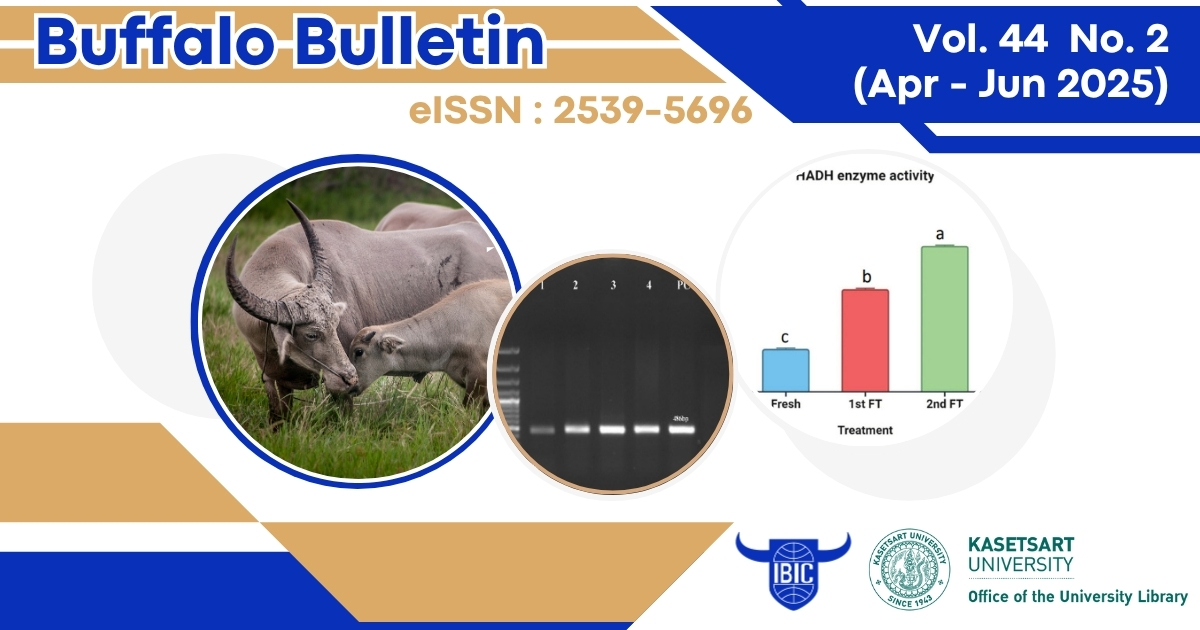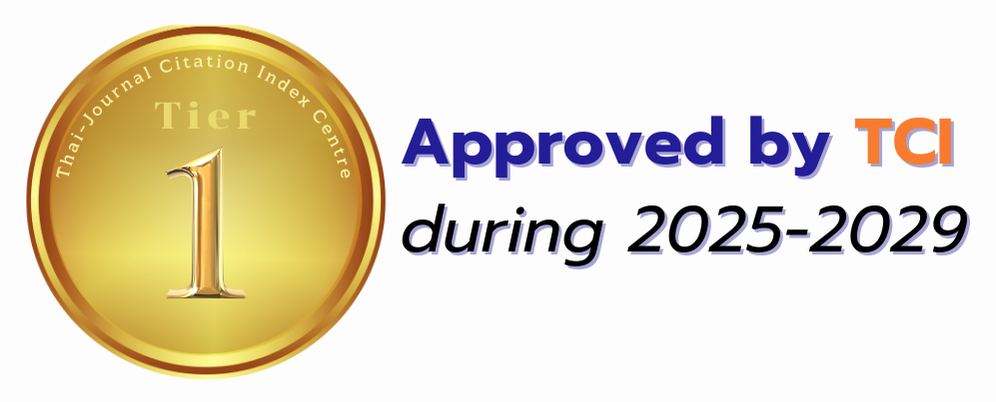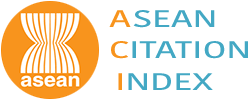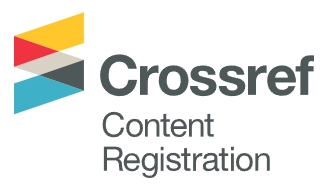ESTIMATED BREEDING VALUES FOR 305 DAYS MILK YIELD TRAITS AND SIRE RANKING OF NILI-RAVI BUFFALOES IN PAKISTAN
DOI:
https://doi.org/10.56825/bufbu.2025.4424621Keywords:
Bubalus bubalis, buffaloes, EBV, Sire summary, 305-days milk yield, Mastitis, Nili-Ravi buffaloes, antibiotic sensitivity, EnrofloxacinAbstract
Pedigree records of 2,881 buffaloes sired by 162 bulls from four Livestock Experiment Stations in Punjab, Pakistan were used. The objective of this study was to estimate the breeding values of animals for different traits to rank the sires and estimation of genetic trends. An Animal Model incorporating all known relationships was used for estimating variance components and breeding values. The estimation of (co)variances and breeding values were obtained using the Derivative Free Restricted Maximum Likelihood (DFREML) set of computer program. The JAA computer program was used for the estimation of reliability of breeding values. The mean estimated breeding value for 305-day milk yield (kg), was -23±287 kg, with an overall genetic trend of +3.5 kg ranged -3.4 to 10.2 kg among different herds. Sires were ranked based on their breeding values along with reliability. 305 days milk yield regression line showing negative genetic trend (Y = -58.084+3.870X). Genetic trend in the recent past decade was negative for the trait indicating that selection strategy especially for choosing young bulls in the artificial insemination program and progeny testing needs to be reevaluated.
Downloads
Metrics
References
Aziz, A.M. 1994. Sire evaluation and environmental and genetic trends of milk yield of water buffaloes, Alexandria. J. Agric. Res., 39(2): 129-148.
Bhatti, A.A., M.S. Khan, Z. Rehman, A.U. Hyder and F. Hassan. 2007. Selection of Sahiwal cattle bulls on pedigree and progeny. Asian-Austral. J. Anim. Sci., 20. DOI: 10.5713/ajas.2007.12
Cady, R.A., S.K. Shah, E.C. Schermerhorn and R.E. McDowell. 1983. Factors affecting performance of Nili-Ravi buffaloes in Pakistan. J. Dairy Sci., 66(3): 578-586.
Catillo, G., B. Moioli and F. Napolitano. 2001. Estimation of genetic parameters of some productive and reproductive traits in Italian buffalo. Genetic evaluation with BLUP-animal model. Asian-Austral. J. Anim. Sci., 14(6): 747-753. Available on: https://www.animbiosci.org/upload/pdf/14-106.pdf
Cilek, S., H. Orhan and A.K.E.H. Sahin. 2008. Estimation of breeding values of Anatolian population of Simmental cows using test day milk yields. Arch. Zootech., 11: 79-85. Available on: https://ibna.ro/arhiva/AZ%2011-4/AZ%2011-4%2009%20Cilek-updated.pdf
Dahlin, A. 1998. Genetic studies on Sahiwal cattle in Pakistan. Ph.D. Thesis, Swedish University Agricculture Sciencse, Uppsala, Sweden.
Dutt, T., K.L. Raheja and V.K. Taneja. 1996. Estimation of sires breeding values and genetic and phenotypic trends for various economic traits in Murrah buffaloes. Indian J. Anim. Sci., 66: 1145-1148.
Faraz, A., N.A. Tauqir, A. Waheed and A. Hameed. 2021a. Effect of exogenous oxytocin administration on the performance of lactating Nili Ravi buffalo. Iranian J. Appl. Anim. Sci., 11(3): 517-525.
Faraz, A., A. Waheed, N.A. Tauqir, H.M. Ishaq, F. Iqbal and Z. Huma. 2021. Feedlot performance and serum profile of buffalo (Bubalus bubalis) calves under high input feeding systems. Buffalo Bull., 40(2): 325-333. Available on: https://kuojs.lib.ku.ac.th/index.php/BufBu/article/view/2981
Henderson, C.R. 1973. Sire evaluation and genetic trends, p. 10-41. The Proceedings of the Animal breeding and Aenetics Symposium in Honor of Dr. Jay L. Lush, Virginia Polytechnic Institute and State University, American Society of Animal Science and American Dairy Science Association, Virginia, USA.
Khan, M.S. 1998. Animal model evaluation of Nili-Ravi buffaloes. The Proceedings of the 6th World Congress on Genetics Applied to Livestock Production, University of New England, Armidale, Australia.
Khan, M.S. 2000. Lactation length adjustment in Nili-Ravi buffalo: A new procedure. Buffalo Newsletter, 14: 4-5.
Khan, M.S., M.A. Chaudhary and M.M. Bhatti. 1999. Progeny testing in Nili-Ravi buffaloes: Ranking of bulls for first six batches. Buffalo Newsletter, 13: 1-5.
Khattab, A.S. and K.A. Mourad. 1992. Estimation of genetic parameters and genetic trends for some milk traits in a herd of Egyptian buffaloes. Egyptian Journal of Animal Production, 29(2): 173-184.
Metry, G.H., H.A. El-Rigalaty, J.C. Wilk and R.E. McDowell. 1994. Factors affecting the performance of Egyptian buffalo. Annals of Agricultural Science, 32(2): 827-841.
Meyer, K. 1997. Estimation of variance components with large-scale dominance models. J. Dairy Sci., 80(5): 965-974. DOI: 10.3168/jds.S0022-0302(97)76021-1
Misztal, I. 1997. Sparsem Collection of Sparse Matrix Modules for Fortran 90. Available on: http://nce.ads.uga.edu/~ignacy/f90 or at ftp://num.ads.uga.edu
Moioli, B., J. Mäki-Hokkonen, S. Galal and M. Zjalic. 2000. Animal recording for improved breeding and management strategies for buffaloes. The Proceedings of the Workshop Held in Bled, Slovenia.
Pilla, A.M. and B.M. Moioli. 1992. Genetic evaluation of buffaloes for milk yield using the animal model. Zootech Nutr. Anim., 18(5): 207-218.
Reddy, C.E. and V.K. Taneja. 1984. A note on factors influencing the first lactation traits of Nili-Ravi buffaloes. Indian J. Dairy Sci., 37(1): 36-39.
Thevamanoharan, K. 2002. Genetic analysis of performance traits of swamp and riverine buffalo. Ph.D. Thesis, Katholieke University, Leuven, Belgium.
Yadav, K.N., S.S. Rathi, S. Rau and R. Singh. 1983. Estimates of genetic and phenotypic trends in Murrah buffaloes under progeny testing programme. Indian J. Dairy Sci., 36: 320-330.









.png)








